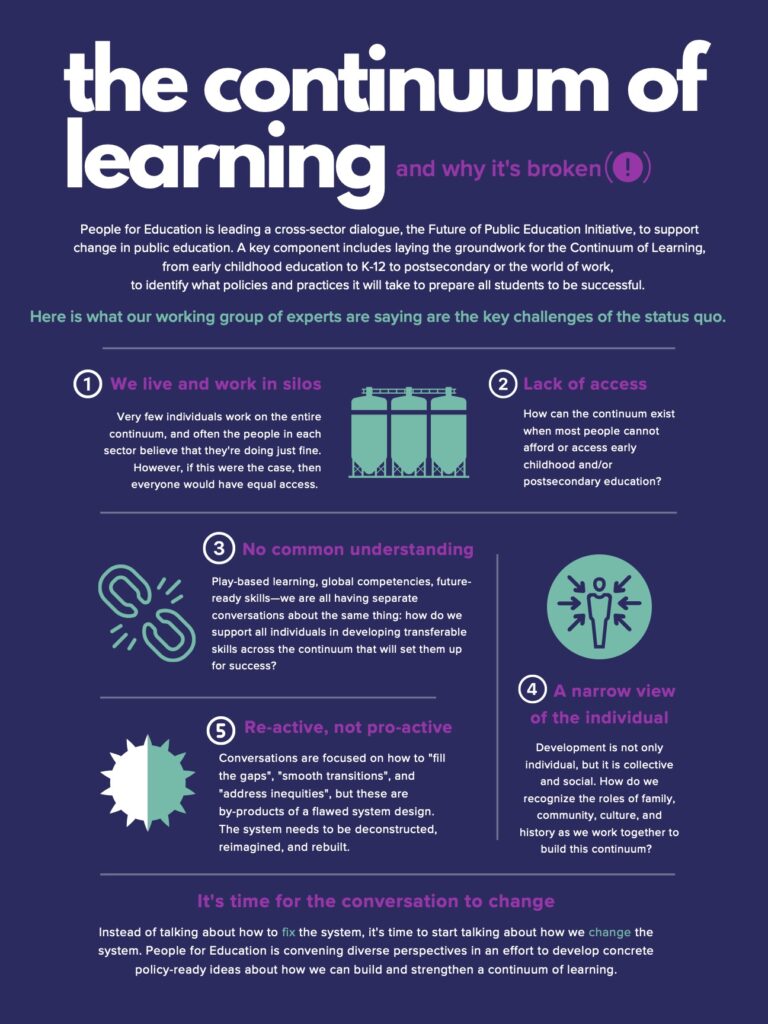All children and young people in Canada should have a right to learn along a seamless continuum from early childhood through to adulthood and careers.
But currently – the continuum is broken.
Continuum of Learning
Is it time for change in education?
Today’s children will be graduating into a world we cannot yet imagine, and education will be their key to success. But that success is currently dependent on navigating a disconnected, disjointed set of systems from early childhood through to post-secondary education and employment.
People for Education is working to support system change so that all children and young people are supported to learn within a seamless, high quality, publicly funded continuum – from early childhood through to adulthood; a continuum of learning that will equitably prepare them with the skills and competencies they need to thrive and engage in their futures.
Frequently Asked Questions
Please select the plus (+) icon to the right of each topic to learn more on our frequently asked questions
What stands in the way of a continuum in our current systems?
In Canada, there is little policy to support education along a continuum.
In most provinces and territories, the different “levels” of education are overseen by separate ministries or discrete departments within ministries. Cooperation and collaboration is rare. For example, there are jurisdictions where ministries responsible for post-secondary education will not share data with ministries responsible for K to 12 education.
In large part because of these divisions, each education sector – early childhood, K-12, post-secondary, workplace – has its own “language” and definitions of skills, competencies, and goals.
There is also little infrastructure to support students as they make transitions or to support educators and staff to work across system divides. Thus, navigating the pathway along the continuum becomes the responsibility of individuals and is experienced inequitably.
Currently, not all components of education are universally accessible – both early childhood education and post-secondary education come with a cost that creates barriers to participation.
Why is a continuum of learning important?
Today’s children will be graduating into a world we cannot yet imagine, and education will be their key to success.
However, their future needs – and the future needs of Canada – will not be met in the current education system. If we only start thinking about whether or not learners are well-prepared for a modern economy and a complex world after they have graduated from high school, it will be too late.
What would a true continuum of learning look like?
If learning in Canada took place along a continuum there would be a cohesive and seamless progression of learning that would work for all students – starting in the early years, or even at birth, and progressing through to K-12, to post-secondary education, and finally the world of work.
How are skills and competencies defined in the different systems in Canada?
People for Education conducted an inventory of the current skills frameworks that developed at the provincial and territorial level in Canada. Nearly all jurisdictions have separate – and not necessarily complementary – frameworks for early years, K to 12, and post-secondary. We also included some frameworks from non-governmental organizations.
What is the goal for this work?
The goal of this work is to ensure that all Canada’s young people, especially those who from marginalized groups (Black, Indigenous, and racialized individuals), are prepared to succeed in a future that is unknown and filled with both challenges and opportunities. This goal will be achieved by developing adoptable, attainable, and accountable policy proposals that promote continuity and coherence throughout every child’s education.
Who is part of the Continuum of Learning Working Group?
The Continuum of Learning Working Group consists of stakeholders across the education sector, from early years to post-secondary education and the world of work, who are passionate about the future of public education. It includes students, employers, experts from early childhood, K-12 and post-secondary education, think tanks, policymakers, and academics.

Related publications
Connecting the Dots: Early years as the starting point in the ‘continuum of learning’
The world is changing rapidly and facing challenges that require us to
engage the minds and efforts of our entire pool of human talent — from our
youngest learners to lifelong learners.
Beyond the economy: the human benefits of early learning and childcare programs
There is extensive evidence to show that children who participate in early learning and childcare programs are better prepared for kindergarten, elementary, and secondary school, increasing their chances for a successful future.

